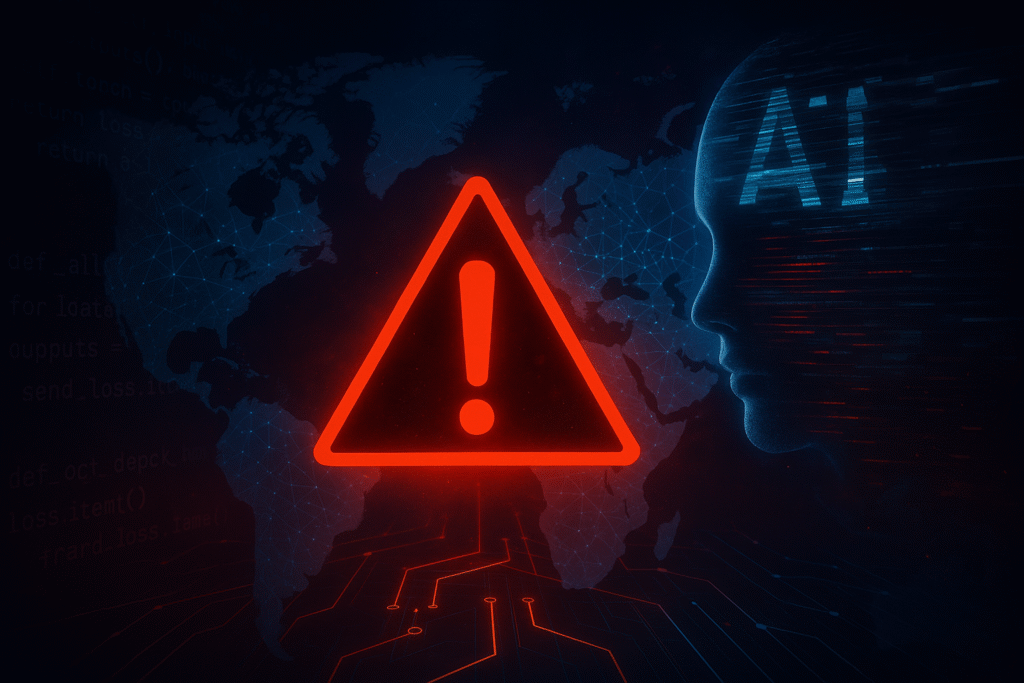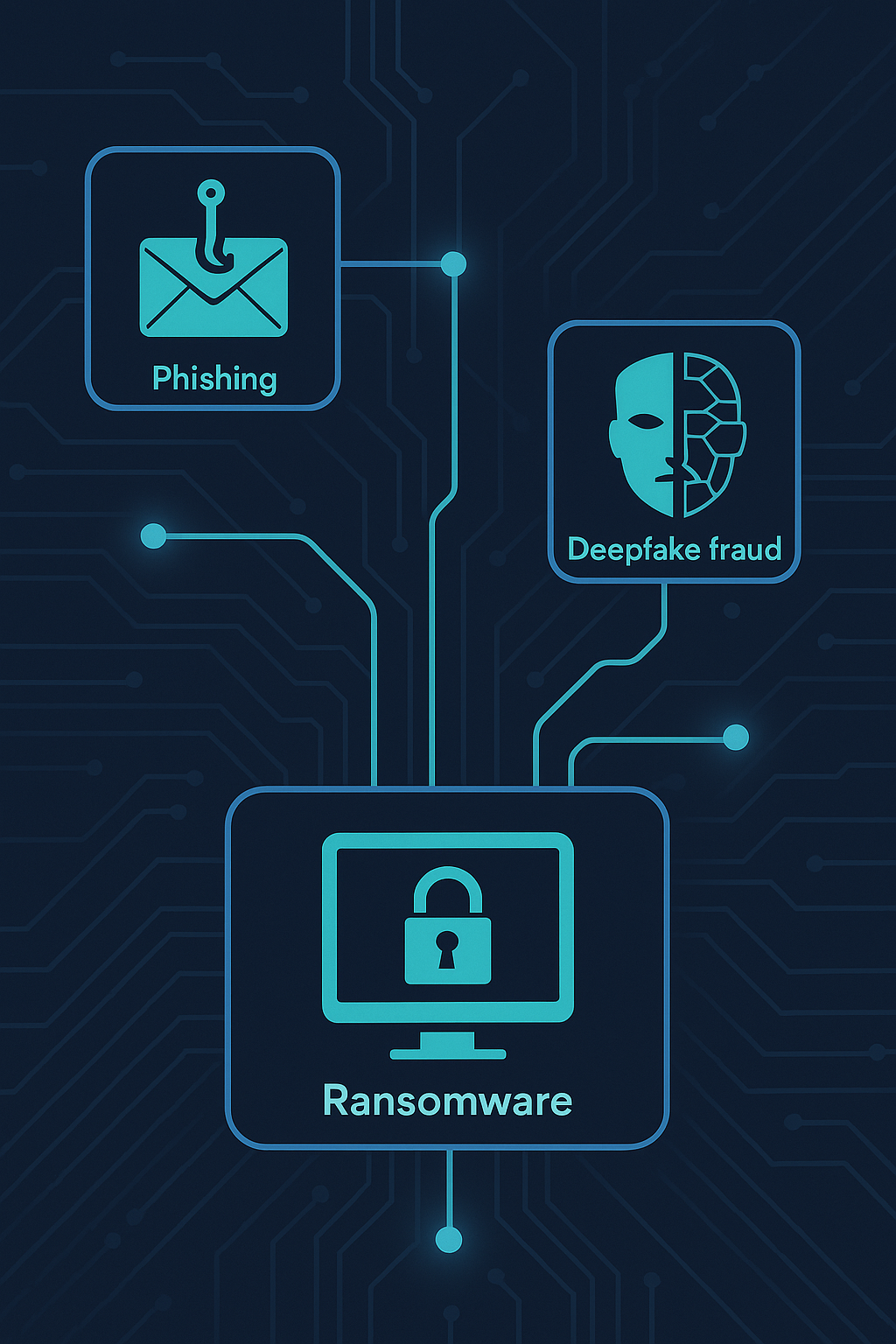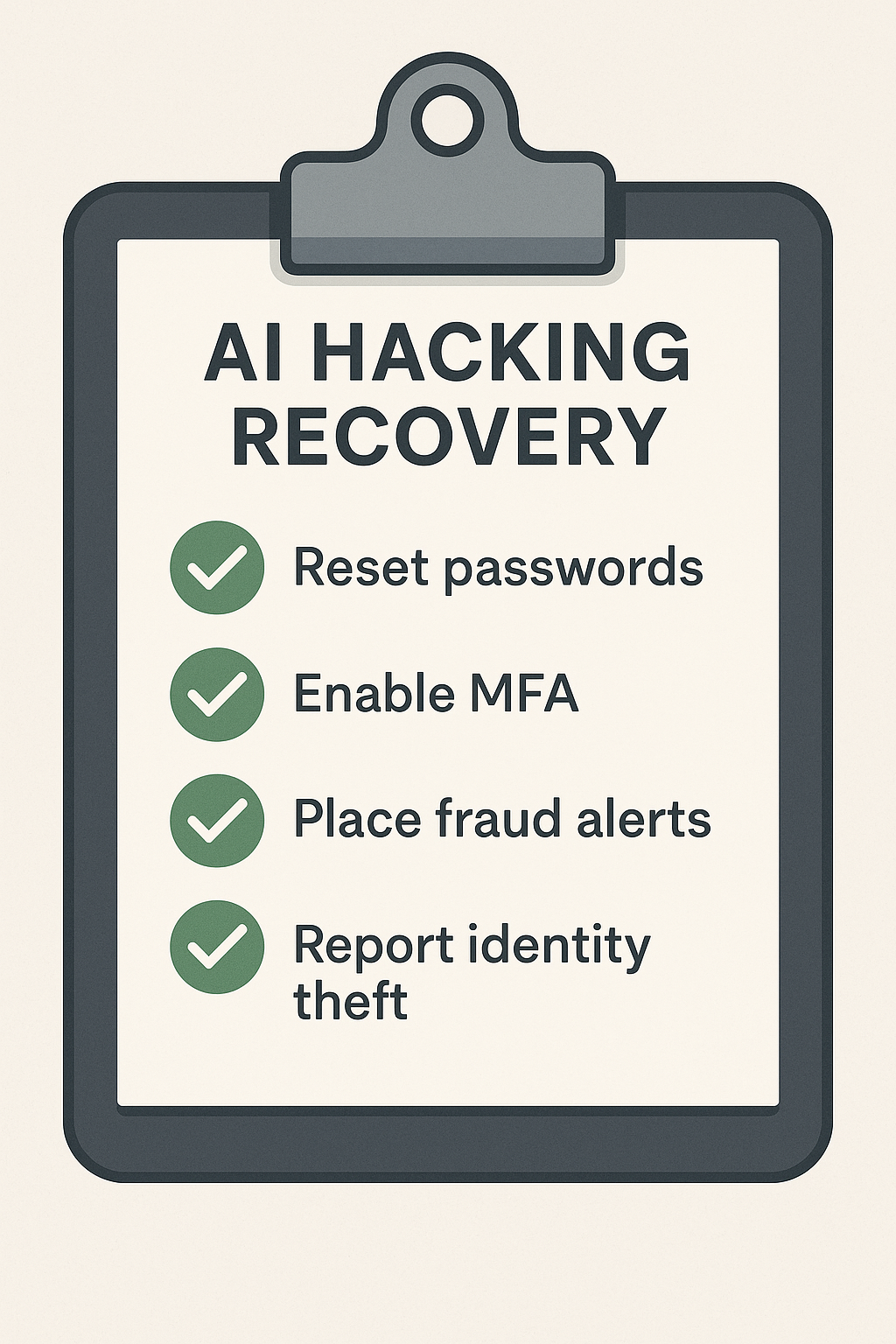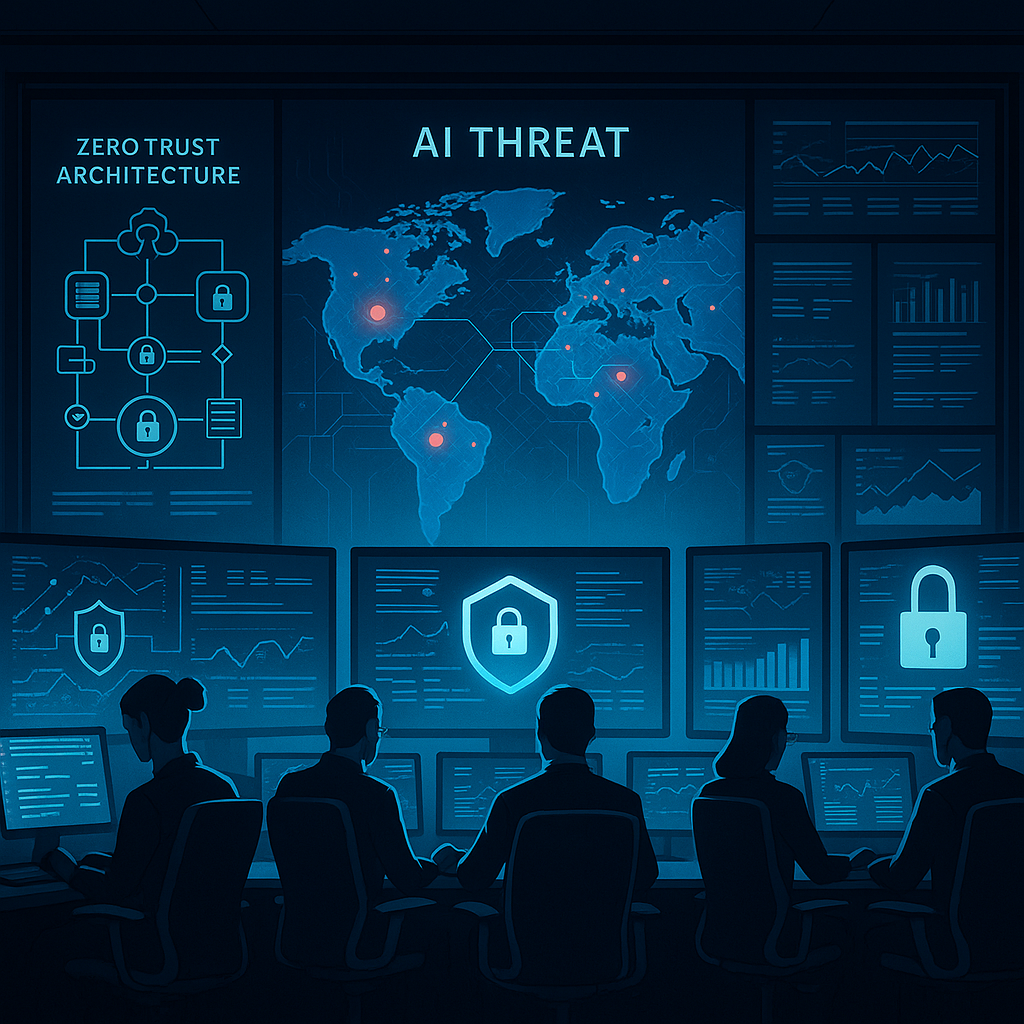
The scale and speed of today’s incidents demand a clear plan for AI hacking recovery. In 2024, consumers reported 12.5 billion dollars in fraud losses, and the share of people who lost money jumped from 27 percent to 38 percent in one year. At the enterprise level, ransomware showed up in 44 percent of breaches studied in Verizon’s latest cycle, with a 37 percent year over year increase, while human factors still played a role in about 60 percent of cases. These figures explain why AI hacking recovery must be designed for professionals and policymakers who need concrete steps, verified research, and repeatable playbooks.
AI is not just accelerating phishing or brute force attempts. It is powering deception that looks and sounds human, and it is scaling criminal operations across borders through marketplaces that sell data, deepfakes, and synthetic identities. Microsoft reports a doubling of synthetically generated text in malicious emails over two years, which further complicates AI cyber attack response across public institutions and regulated industries. You will see the term AI hacking recovery throughout this guide. It signals a systematic approach that blends fast containment with disciplined remediation.
In this article we begin by defining the current threat picture and the urgency behind AI hacking recovery. We then move into immediate actions, device and account hardening, financial and identity protections, professional incident response, and long-term AI-powered cybercrime protection that meets enterprise standards. Along the way, you will find internal links to deeper tactical pieces and real case studies that illustrate how to recover from AI hack scenarios without guesswork. The next section explains why this moment is different, and why AI security breach steps must adapt to a rapidly changing landscape.
Subscribe now to join readers who are decoding the new cyber battlefield in our Quantum Cyber AI Brief.
Understanding AI Hacking and Why It Matters

AI has changed the economics of cybercrime. Stolen data now fuels a crime-as-a-service ecosystem where toolkits, deepfake capabilities, and multilingual lures are traded and reused across regions, which expands attacker reach with minimal friction. AI hacking recovery needs to account for this modular production model because it allows attackers to iterate fast after every takedown. When we discuss AI cyber attack response for agencies, enterprises, and critical infrastructure, we are describing a race between defenders who must validate signals and adversaries who can produce convincing noise at scale.
Microsoft’s latest intelligence shows synthetically generated text in malicious emails has doubled in two years, which raises the baseline for social engineering and increases the pressure on your AI security breach steps at the inbox and helpdesk levels. This context should inform every AI hacking recovery plan you build.
Current breach trends reinforce that urgency. Verizon reports ransomware in 44 percent of breaches studied for the 2025 period, with a 37 percent year over year climb, and about 60 percent of breaches involve human factors that AI-enhanced lures exploit. On the consumer side, reported fraud losses hit a record 12.5 billion dollars in 2024, and more people who reported to the FTC lost money than in prior years. This increases downstream identity theft risk during AI hacking recovery and complicates how to recover from AI hack incidents at scale. Since attackers can source deepfake voice, video, and documentation quickly, organizations need AI-powered cybercrime protection that treats verification and authorization as multi-step processes with friction where it matters.
If you want a deeper dive into attacker methodologies and tooling shifts, see our analysis of how cybercriminals are weaponizing AI, which maps directly to the techniques driving today’s social engineering and credential theft. You can read more in our piece on how cybercriminals are weaponizing AI in 2025 for a practical view of attacker workflows that pressure AI security breach steps in the field.
In policy and operations, the result is a widening gap between incident volume and human review capacity. AI hacking recovery is about closing that gap with precise controls and tested playbooks. It is also about building a culture that expects imposters, verifies identity out of band, and logs every exception for audit. Hackers move fast. Governments and large enterprises often do not. Get weekly insights on AI-driven threats, deepfake scams, and global cyber shifts before they hit the headlines.
The threat picture is only useful if it translates into action, which is why the next section lays out immediate steps that any team can execute during the first critical hours of a breach.
Immediate Steps to Take After a Breach

Speed matters in AI hacking recovery. Your goal is to contain, verify, and preserve evidence without destroying logs that you need later. Start with account lock-down. Immediately reset passwords for email, identity providers, financial accounts, and any admin consoles. Force sign-out of all active sessions, revoke suspicious tokens, and turn on multifactor authentication for every affected account. The FTC provides a clear checklist for account recovery that aligns with these AI security breach steps and should be your default playbook for how to recover from AI hack scenarios at the user level. Treat this as the first phase of AI cyber attack response.
Next, reduce identity and financial exposure. Place an initial fraud alert at one of the three nationwide credit bureaus. Pull your credit reports, scrutinize new accounts or hard inquiries, and consider a credit freeze if there is evidence of misuse. The FTC explains timelines, rights, and practical actions for victims in plain language, which makes it suitable for AI hacking recovery across consumer and small business contexts. If any personal identifiers were exposed, file a report and get a personalized plan through IdentityTheft.gov. This resource generates letters, affidavits, and step lists you can use in formal responses and is a reliable guide for AI-powered cybercrime protection after first containment.
Document everything. Do not wipe systems until you capture volatile evidence such as running processes, network connections, and authentication events. For organizations, designate a single incident log to timestamp actions, commands, and changes. Use ticket numbers to connect decisions to people and systems. The FTC’s business breach guide adds a structured escalation path that includes engaging legal counsel, notifying affected parties where required by law, and coordinating with law enforcement. It also lists common mistakes to avoid, which supports disciplined AI cyber attack response in regulated sectors. This documentation becomes the backbone of AI hacking recovery reports and post-incident reviews.
Communicate with precision. Switch to out-of-band channels for critical coordination in case primary systems are compromised. Provide only validated facts to executives and external stakeholders. Avoid guessing. If ransomware is suspected, quarantine affected endpoints, segment impacted networks, and prepare to reference relevant CISA advisories in the next phase. This will keep your AI security breach steps aligned with best practice while you stabilize core identity and access systems. These actions form a repeatable approach to how to recover from AI hack incidents without losing control of the narrative or the evidence you need for remediation.
With the first hours contained and documented, the next priority in AI hacking recovery is hardening accounts and devices so the attacker cannot reenter through the same doors.
Securing Your Accounts and Devices

After initial containment, AI hacking recovery shifts to locking down the technical entry points that attackers may try to reuse. Accounts and endpoints must be hardened so the same exploit cannot succeed twice. This is where AI security breach steps focus on prevention layered with resilience.
Multifactor Authentication as a Baseline
Multifactor authentication (MFA) is no longer optional. CISA stresses turning on MFA for all critical accounts and choosing phishing-resistant methods when possible, such as hardware tokens or passkeys. Adding a second factor reduces the chance that stolen credentials can be reused in another AI cyber attack response cycle. MFA should be enforced not just on user accounts but also on administrator dashboards, cloud services, and remote access systems. Organizations that fail to implement MFA expose themselves to credential replay and brute force attempts that AI can now automate at unprecedented speed.
Strong Password Hygiene
Weak or reused passwords are the fastest route back into a compromised system. CISA advises creating unique, strong passwords for every service and using a password manager to reduce reuse. For how to recover from AI hack incidents, replacing old credentials is not enough. You must upgrade to stronger policies that require complexity, rotation, and randomization. Attackers are deploying AI to crack common patterns and dictionary-based passwords faster than ever, which makes basic hygiene central to AI hacking recovery.
Patch and Remediate Quickly
Software vulnerabilities remain one of the top access vectors. Verizon found that exploitation of vulnerabilities accounted for 20 percent of initial access in the 2025 breach cycle, with zero-day exploits increasingly targeting VPNs and edge devices. Median remediation time was 32 days, and only about 54 percent of edge device flaws were fully patched. That lag gives adversaries a wide window to exploit. AI security breach steps must include prioritized patching and continuous vulnerability management. It is not enough to schedule quarterly cycles. Adopt a rolling patch strategy, track high-severity CVEs, and ensure remediation covers both systems and dependencies.
Real-world ransomware cases illustrate the consequences of delays. As shown in our report on the LockBit ransomware hack, criminals exploit known vulnerabilities when organizations leave systems unpatched. Linking these cases into your AI hacking recovery program builds urgency and gives stakeholders a practical example of why patch discipline is non-negotiable.
For patch discipline and ransomware containment details that reinforce AI security breach steps, see LockBit Ransomware Hack: 7 Brutal Truths Exposed.
With accounts secured, passwords hardened, and systems patched, the next frontier of AI hacking recovery involves defending financial assets and identity data, where deepfake scams and business email compromise are already creating record losses.
Protecting Financial and Personal Data

AI hacking recovery does not stop at technical remediation. The next target is financial and identity data, where losses can spiral quickly once attackers gain a foothold. AI security breach steps in this area are designed to protect both organizational funds and individual accounts from fraud that is increasingly powered by deepfakes and synthetic communications.
Business Email Compromise Losses
Business Email Compromise (BEC) remains one of the most financially damaging attack types. The FBI’s Internet Crime Complaint Center (IC3) tracked nearly 8.5 billion dollars in BEC losses between 2022 and 2024, with about 2.8 billion dollars in 2024 alone. These figures show why AI cyber attack response must prioritize email verification and wire transfer controls. Attackers are blending AI-generated content with spoofed executive communications to create convincing requests that slip past overworked staff. AI-powered cybercrime protection in this space requires both technology and training, with layered approvals for sensitive financial actions.
Consumer Safeguards
For individuals hit by AI-enhanced fraud, identity theft defenses are critical. The FTC recommends placing fraud alerts with credit bureaus, reviewing reports for unauthorized activity, and freezing credit if misuse is suspected. These measures limit new-account fraud and slow the pace of damage. They are central to how to recover from AI hack incidents when personal data has been exposed. AI hacking recovery at the consumer level means pairing technical fixes with financial defense, since attackers often recycle stolen identities for months.
Case Study: Arup Deepfake Scam
The risk is not theoretical. In 2025, staff at Arup were tricked into transferring 25 million dollars during a deepfake video conference that convincingly mimicked senior leadership. The company’s CIO later described how attackers used AI-generated visuals and voices to pass multiple verification steps. This case demonstrates how AI-powered deception can bypass ordinary defenses, making it a key example in AI hacking recovery planning. For financial and personal data protection, out-of-band verification, layered controls, and employee awareness programs must become the default.
For a broader view of how attackers use synthetic personas in fraud operations, see our detailed breakdown of the North Korean deepfake job scam. It highlights red flags and illustrates the same tactics deployed in corporate fraud. Linking both examples strengthens any AI security breach steps you design around financial controls.
For a focused look at synthetic-identity fraud that pressures finance teams, read North Korean Deepfake Job Scam: 7 Shocking Red Flags.
Financial and identity safeguards are only part of recovery. Complex attacks often require professional response teams and coordinated reporting to contain the damage. That is where the next phase of AI hacking recovery begins
Working with Professionals for Full Recovery
Complex incidents often exceed the capacity of internal teams. AI hacking recovery benefits from early engagement with specialized responders who understand how AI-enabled intrusion sets move through identity systems, cloud consoles, and business processes. Treat this as an extension of your AI cyber attack response rather than a handoff. Align legal, compliance, security operations, and communications in one unified workstream so your AI security breach steps remain defensible and well documented. If there are indicators of ransomware, use established guidance to prioritize containment, restoration, and reporting.
CISA’s joint advisory on Play ransomware outlines practical actions that generalize to many families, including verifying multifactor authentication, closing remote desktop exposure, and hardening edge devices before bringing systems back online. This framework belongs in every plan for how to recover from AI hack scenarios that include encryption or data theft claims.
Professional responders will also profile the adversary. Groups such as Scattered Spider have demonstrated an ability to social engineer helpdesks to reset multifactor authentication, harvest session tokens, and pivot inside identity systems. CISA’s advisory documents the techniques and the mitigations that reduce repeat compromise, including strict verification for helpdesk password resets and out-of-band approvals for MFA changes. Use those controls as part of AI-powered cybercrime protection. They harden the exact chokepoints that modern social engineers attack, and they align with a disciplined AI hacking recovery roadmap.
Financial loss and wire fraud require a parallel track. For Business Email Compromise or fraudulent transfers, file a complaint with the FBI Internet Crime Complaint Center as soon as possible. The IC3’s public service announcement explains how BEC has reached an estimated 55 billion dollars in exposed losses worldwide and provides the official reporting flow that banks and investigators use to attempt recovery. This step supports your AI cyber attack response by creating a record, triggering interbank notifications, and demonstrating due diligence to regulators and insurers. It also complements your internal AI security breach steps, such as freezing suspect vendor accounts, disabling forwarding rules, and rotating tokens on mail, identity, and finance platforms.
During triage, keep evidence preservation and change control strict. Maintain a single incident log that timestamps every action, tool, and system affected. Snapshot volatile data before reimaging. Align communications to facts that have been validated by responders. If your organization handles regulated data, have counsel align notifications with the FTC’s breach response framework and any sector rules you must follow. This discipline improves outcomes in AI hacking recovery because it reduces rework and ensures that each mitigation follows a documented rationale that auditors can trace.
Once responders stabilize systems and financial exposure, your next priority is to turn lessons into durable defenses that anticipate the next wave of attacker automation. The next section walks through preventative controls that raise the cost of intrusion while keeping AI-powered cybercrime protection practical for real teams.
Preventing Future AI-Driven Attacks

AI hacking recovery is not complete until lessons are transformed into preventative controls. The goal is to ensure the same weaknesses are not exploited again. AI-powered cybercrime protection depends on anticipating attacker automation and social engineering rather than waiting for the next incident.
Building a Zero-Trust Security Model
Zero-trust frameworks assume no user or device is inherently trusted. Every request must be verified. Microsoft warns that AI-generated deception is accelerating, with a sharp rise in synthetic email content designed to bypass filters and exploit human behavior. Embedding zero-trust into AI security breach steps forces continuous authentication, segmented access, and monitoring that detects anomalies faster. This approach is the foundation for long-term AI hacking recovery and reduces reliance on a single control.
Strengthening Organizational Resilience
CISA’s advisory on the Interlock ransomware family underscores the need for tested recovery plans, DNS filtering, and web application firewalls, alongside multifactor authentication. These defenses buy time when AI-enabled intrusion attempts scale up. AI cyber attack response at the organizational level should focus on layered resilience that makes it costly for attackers to persist. Training programs, red team exercises, and automated backups that are disconnected from production networks all increase confidence in how to recover from AI hack scenarios.
Lessons from High-Profile Cases
The 2023–2024 MGM and Caesars breaches showed how advanced social engineering can cripple major enterprises. A teenager was arrested for allegedly gaining access by exploiting call center and identity verification weaknesses. These cases demonstrate that even companies with significant resources remain vulnerable to AI-assisted tactics. For policymakers, the lesson is clear: prevention requires a systemic approach that integrates both technology and regulation. For organizations, it underscores the urgency of implementing AI-powered cybercrime protection that extends across every business unit.
Preventative strategy is the last step in AI hacking recovery, but it is also the most important. Once accounts are secured and systems restored, investing in forward-looking defense is what keeps organizations out of the cycle of repeated compromise. In the next section, we will summarize these steps, outline the future of AI hacking recovery, and show how governments and enterprises can work together to slow the escalation of AI-driven threats.
Conclusion
AI hacking recovery is not a one-time checklist. It is an operating posture that must evolve as attackers automate social engineering, credential theft, and data extortion. The data points are clear. Ransomware was present in 44 percent of breaches studied for the 2025 period and rose 37 percent year over year, while human factors remained central in about 60 percent of cases. Consumer fraud losses also reached a record 12.5 billion dollars in 2024, which signals a broader criminal economy that feeds identity theft and financial abuse long after the first alert clears. These realities demand AI cyber attack response that blends rapid containment with disciplined, verifiable AI security breach steps.
The path forward is practical. Treat identity, device, and network controls as living systems. Enforce multifactor authentication at scale. Patch relentlessly, especially on edge devices and VPNs that show up repeatedly in breach patterns. Build out-of-band verification for money movement and privileged access. Document everything as you work through AI hacking recovery so that lessons convert into policy, automation, and training. Adopt incident playbooks informed by current advisories to raise your baseline against ransomware and social engineering campaigns that now leverage synthetic content at speed. This is how to recover from AI hack incidents without leaving the same entry points exposed.
AI will keep lowering the cost of high-quality deception. Organizations that win will pair resilient architecture with executive habits that reward verification and rapid decision-making. Use this guide to standardize your AI cyber attack response, then pressure test your teams with red-team exercises that simulate deepfake approvals and helpdesk manipulation. Subscribe here to stay ahead of what’s coming next. The next section condenses these actions into key takeaways you can share with leaders and incident response teams.
Key Takeaways
- AI hacking recovery is a continuous program. Use verified playbooks for identity control, patching, and evidence preservation, then convert lessons into automation that closes known gaps.
- Human factors are still the dominant failure. Train helpdesks and approvers to handle synthetic email, voice, and video while enforcing out-of-band checks for money movement and MFA changes.
- Ransomware frequency and fraud losses justify investment. Prioritize AI cyber attack response that includes tested restoration, segmented networks, and immutable backups.
- Financial controls matter. Pair wire transfer approvals with identity verification designed to resist deepfakes, and report BEC rapidly through the FBI IC3 process to improve recovery odds.
- Policy and operations should align. Follow CISA advisories to guide AI security breach steps and use FTC resources to support consumer and business recovery actions at scale.
FAQ
What is the first action in AI hacking recovery if compromise is suspected?
Reset passwords, force sign-outs, and enable multifactor authentication on affected accounts. Follow the FTC’s step-by-step account recovery guidance to avoid missing critical AI security breach steps.
How can organizations reduce the risk of deepfake-enabled fraud during payments?
Require out-of-band verification for wire transfers and vendor changes, train approvers on synthetic media, and log all exceptions. Report suspected BEC to the FBI IC3 immediately to increase the chance of claw back.
How fast should vulnerabilities be patched in an AI cyber attack response?
Prioritize internet-facing systems and edge devices. Verizon reports a median 32-day remediation time and significant exposure on edge hardware, which suggests the need for faster cycles tied to exploitability signals.
Should law enforcement be involved even if losses seem small?
Yes. Early reporting creates a record that supports recovery, improves intelligence for others, and demonstrates diligence to regulators and insurers. Use the official reporting flows and preserve evidence before reimaging systems.
